There is no question that the Andalusian horse is one of the most striking equine horse breeds that exist today, even as it remains a mystery to many equestrians. If you are lucky enough to encounter an Andalusian horse in person, you will likely remember the experience for years to come.
The Andalusian horse breed originated in the Iberian Peninsula located in the southwest region of Europe. It is an ancient horse breed that has existed since the 1400s, overcoming adversity and near extinction along the way.
The more you learn about the Andalusian horse breed, the better you will understand its majestic allure. The following facts will shed some light on exactly why this breed has survived for so long.
Table of Contents
15 Facts About the Andalusian Horse Breed
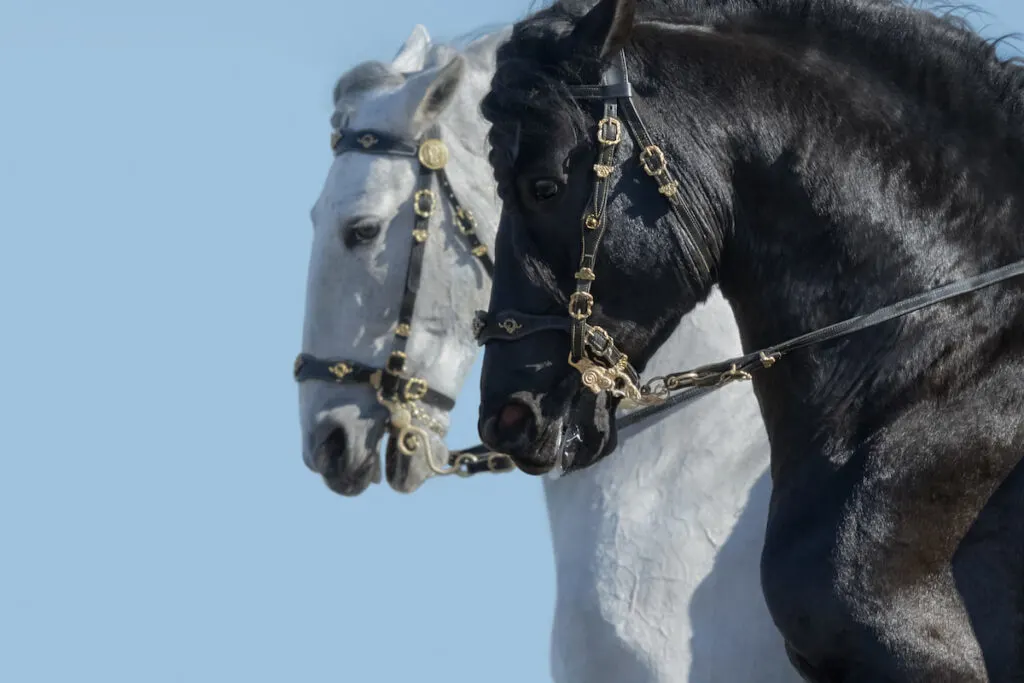
1. Andalusians Were War Horses
Andalusian horses have friendly demeanors, muscular builds, and striking appearances, which once made them ideal war horses.
During the Middle Ages and the 19th century, soldiers preferred Andalusian horses because they could withstand the physical and mental demands of warfare.
Leaders of the time favored Andalusian horses over other horse breeds due to their elegant appearance as well as their popularity as war horses. There is no doubt that this horse breed played a pivotal role in historical wars.
2. The Breed Almost Disappeared in the 19th Century
The Andalusian horse breed came dangerously close to disappearing during the 19th century thanks to several factors.
Warfare during that time, unfortunately, contributed to the loss of many purebred Andalusian horses, a consequence of their popularity as prized war horses.
Diseases of the era led to the death of countless more Andalusian horses. Equestrians at the time were also crossbreeding these horses, which diminished the number of pure-bred Andalusian horses.
Thanks to the conservation efforts of breed enthusiasts and the leaders of Spain, the Andalusian breed recovered and continues to grow stronger every day.
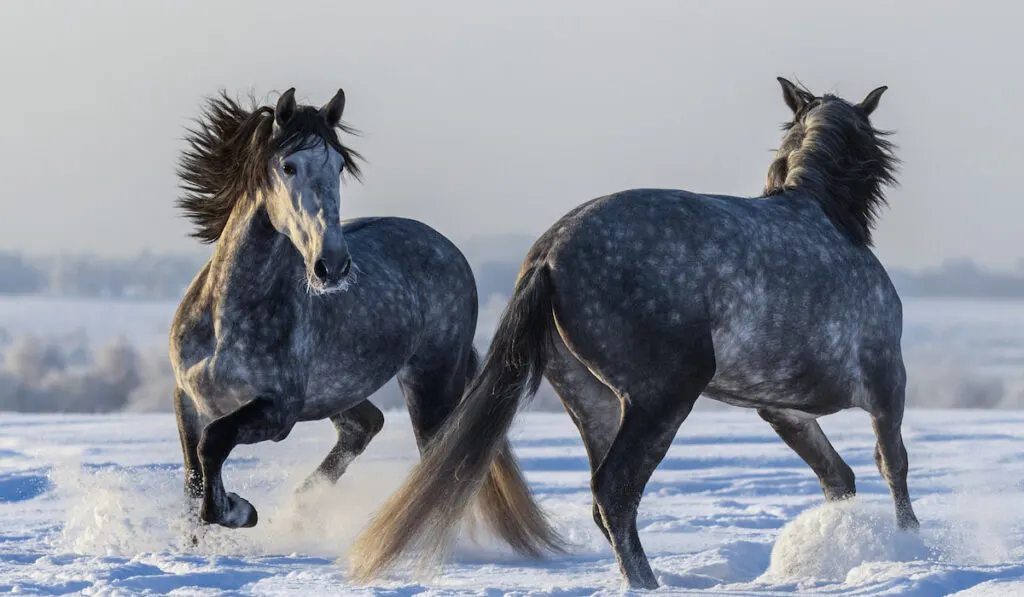
3. Andalusians Are of Spanish Descent
Andalusian horses originated on the Iberian Peninsula, a region sitting in both countries of Portugal and Spain.
These horses were originally known as Spanish horses, and today they are often referred to as ‘pure Spanish’ horses.
Spain was so proud of the horse breed that the Spanish government used them to establish goodwill and diplomacy with other European countries.
4. Andalusians Are a Rare Horse Breed
Despite being a spectacular horse breed, fewer than 60,000 known Andalusian horses exist around the world today!
In the United States, there are 11,000 purebred Andalusian horses and 9,500 crossbred Andalusians.
Over 7 million horses exist in the United States today and 90,000 of those are wild horses. There are more wild horses in this country than there are Andalusian horses in the world.
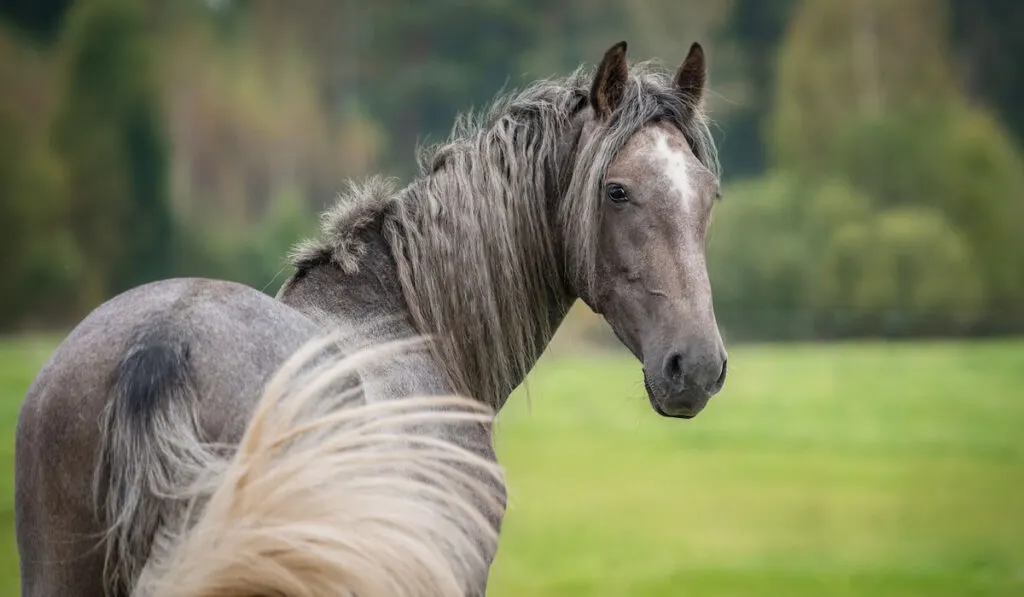
5. Andalusians Can Have Warts Under Their Tail
There are different Andalusian bloodlines that trace back to different sires including the Esclavo bloodline. A characteristic trait of the Esclavo bloodline is warts under the tail.
Andalusian breed enthusiasts still look for this trait as evidence of the Esclavo bloodline.
6. Andalusians Can Have Horns
It may not sound plausible, but some horses within this breed have ‘horns,’ or at least what appear to be horns.
These ‘horns’ are calcium deposits called frontal bosses that appear as short, horn-like growths on the heads of some Andalusian horses.
The calcium deposits grow specifically around their ears or temples and do not tend to break through the skin. Fortunately for horse owners, these ‘horns’ are not dangerous and do not require removal.
7. Andalusians Are More Likely to Suffer from Intestinal Ischemia
Intestinal ischemia occurs more often in Andalusian horses than other horse breeds. It is a group of small intestinal issues resulting in a reduction of blood flow that can prove to be dangerous for horses.
Andalusian stallions are also at a much greater risk of developing an inguinal hernia than horses of other breeds.
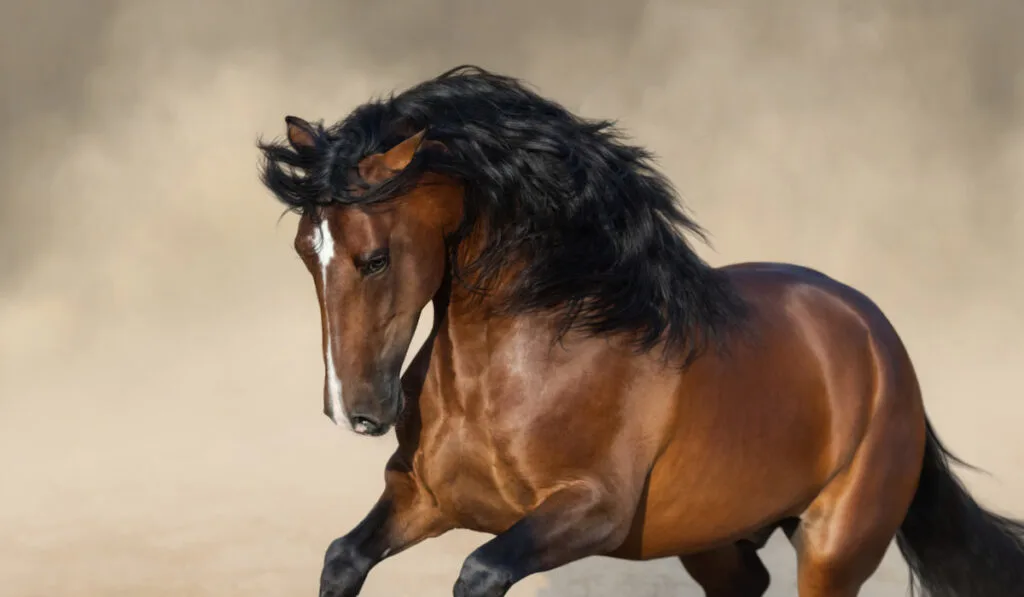
8. Andalusians Are Sometimes Called the “Horse of Kings”
Thanks to their striking profile and regal appearance, many people refer to Andalusian horses as the “horse of kings.” During the Renaissance era, royalty began riding these horses and preferred them over other breeds.
Members of royal families during that time also appreciated the breed’s heritage as prominent war horses. Andalusian horses were calm by nature and easy to train, which only added to their royal appeal.
9. Exporting Andalusians Was Once Banned in Spain
Spain previously banned exports of Andalusians to save the breed from disappearing altogether following wars and disease epidemics.
Before the 1960s, it was illegal to export Andalusians from Spain to other countries.
The breed’s popularity had also waned prior to the 20th century, in part due to its extreme rarity. In the 1960s, the breed had recovered enough for Spain to allow exports of the breed to other countries like the United States.
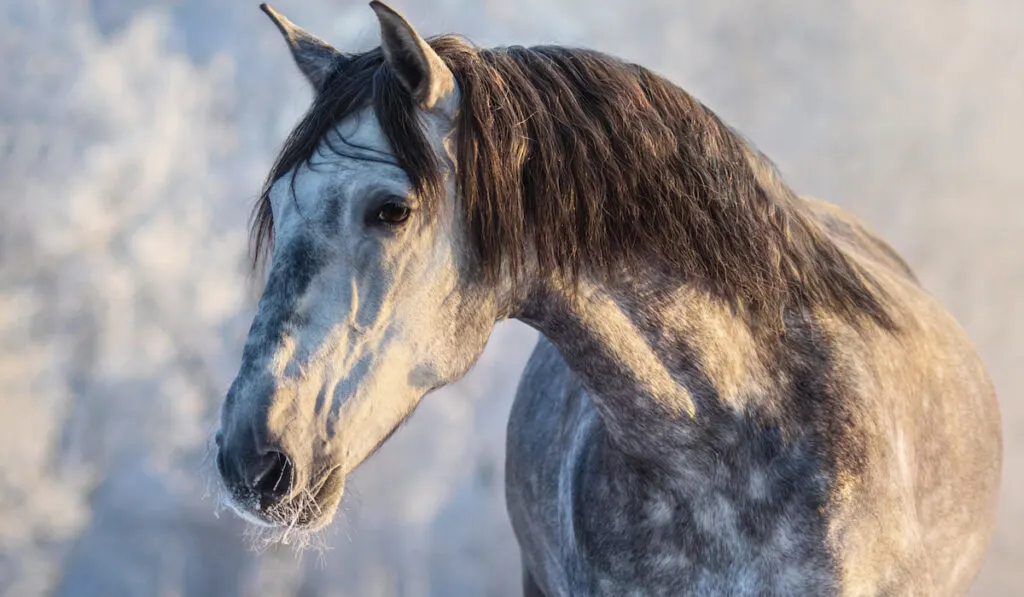
10. Most Andalusians Are Gray or Bay
In the United States, most Andalusian horses have gray coats. Only about 15% of the remaining horses are bay colored.
Being bay colored means that they have brown hair with black hair on their mane, tail, ears, and lower legs.
Andalusians can have other coat colors including cremello, dun, palomino, chestnut, buckskin, or black. Anything besides bay or gray coats on a full-blooded Andalusian horse is uncommon.
11. Andalusians Influenced Other Horse Breeds
The Andalusian horse breed was once so popular that many horse breeders used it to crossbreed and create new horse breeds. The Lipizzaner horse breed counts the Andalusian horse as its foundation breed.
Historians also believe that the Andalusian horse was instrumental in the creation of other breeds like the Connemara, American Quarter Horse, Peruvian Paso, and several German warmblood horse breeds.
12. Andalusians Are Naturals in Dressage
Dressage is an equine exhibition competition that many equestrians refer to as art or dance. Riders essentially display their horse’s extensive training and obedience in the show ring.
Andalusian horses are docile and easy to handle, making them ideal for dressage competition. Their elegant appearance and regality make them successful dressage competitors.
13. Andalusians Have a High Risk of Laminitis
Laminitis is a hoof disease that causes lameness, or an inability of horses to walk. Andalusian horses are more likely to develop this disease than other horse breeds.
Laminitis is treatable and curable in some cases if a veterinarian diagnoses it early. The disease can be fatal in extreme, untreated cases where the horse becomes unable to stand up at all.
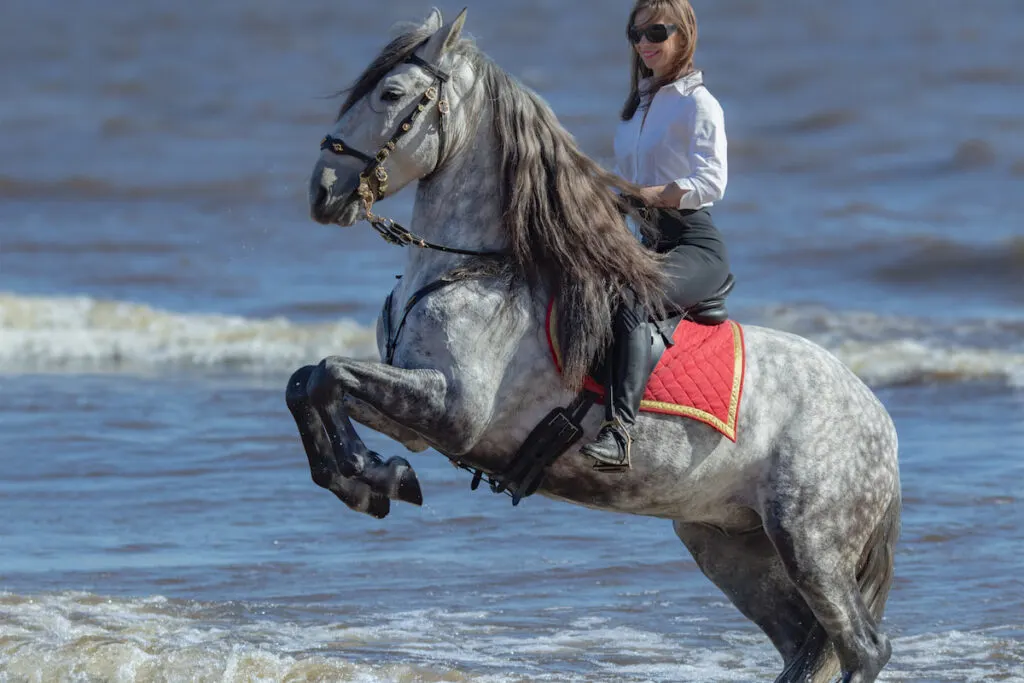
14. Andalusians Are Popular in Movies
Thanks to their exquisite appearance and trainability, Andalusian horses are popular in the movie industry.
Blanco, an Andalusian horse, played the part of Gandalf’s trusted stallion named Shadowfax in the Lord of the Rings movie.
Andalusian horses also worked as mounts for actors in movies like Ladyhawke and Pride and Prejudice as well as the popular television show Games of Thrones.
15. Certain Markings on Andalusians Once Meant Good Luck
Many years ago, if an Andalusian horse had certain markings, people believed the horse had good luck and a good character.
Some equestrians mistakenly believed that white socks on an Andalusian was an indicator of good luck and a friendly personality.
On the other hand, the lack of any white markings on an Andalusian meant that the horse carried bad luck and may even be hard to handle. Luckily, we now know that coat markings have no impact on a horse’s overall character, quality, or luck.
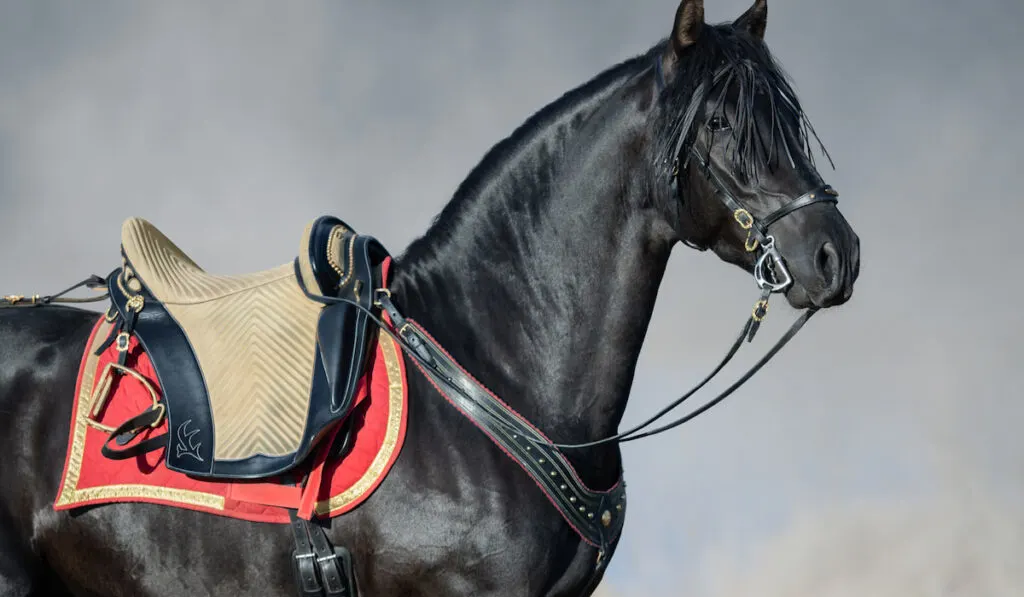
Final Thoughts
Andalusian horses may be rare, but they have withstood the test of time and hopefully, their numbers will continue to grow. From being war horses to becoming the “horse of kings” to appearing in movies alongside famous actors and actresses, the Andalusian horse breed has undoubtedly cemented its place in equine history.
Resources
I used the following sources to write this article about the Andalusian horse breed.
- https://en.wikipedia.org/wiki/Andalusian_horse
- https://en.wikipedia.org/wiki/Iberian_Peninsula
- https://web.archive.org/web/20111019014133/http://www.usef.org/_IFrames/breedsDisciplines/breeds/andalusian/about.aspx
- https://horsesonly.com/andalusian-horse/
- https://www.mayoclinic.org/diseases-conditions/intestinal-ischemia/symptoms-causes/syc-20373946
- https://www.horsejournals.com/popular/breed-profiles/ancient-andalusian-horse-kings
- https://en.wikipedia.org/wiki/Dressage#
- https://en.wikipedia.org/wiki/Laminitis
- https://www.sandiegouniontribune.com/lifestyle/people/sdut-lord-of-the-rings-horse-dies-2014apr27-story.html
- https://www.tor.com/2019/05/13/sff-equines-looks-at-the-andalusian/
- https://www.horsejournals.com/popular/interviews-profiles/horses-hollywood-movies
- https://petpedia.co/horse-statistics/

